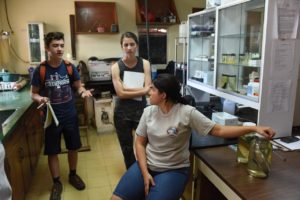2/16/17
Hi, Liam and Sylvia here with an update about our tour of the tuna laboratory at Achotines! Today we visited the yellow-fin tuna culture labs at the Achotines Field Station. Achotines is surrounded by various fish communities, and therefore is a prime location to bring tuna. There are two ways that tunas are taken into the lab: they are either caught by the fishermen or they are grown from eggs in the labs. In both cases the tuna are kept at the laboratory in a variety of different tanks. These tanks are filled with water from the surrounding ocean, and the area around the tanks is manipulated in such a way to ensure that the water will always be the same as the water in the ocean. Scientists and fishermen catch yellow-fin tuna, and put them in special bags to be transported to Achotines. When they arrive they are put in one the main tanks. Experiment tanks allow scientists to change the conditions of the tuna’s new habitat, and observe how they respond. In the main tanks, the tuna spawn everyday during mating season, and do not stop unless the water dramatically changes in temperature, or a female dies. The eggs that are produced are kept and cultured in separate, smaller tanks, and have over a 60% hatch rate. The larvae are kept in similar tanks, and are observed. The fish that are grown from eggs are smaller than the fish caught in the ocean. Currently they are not able to grow the fish to maturity in the tanks. When we visited the lab we viewed the tuna being fed. There were are 24 fish in the tank we viewed, and each were very large. Each fish was around three to four feet. The fish are fed a mixture of squid and sardines which are injected with supplements for the tunas. The tank was about 17 meters in diameter, and 6 meters deep. The scientists do not know the sex of the fish by their physical features but can determine by behavior. Some fish have died because the scientists have no way of knowing that each fish gets the proper amount of food or for other reasons. The lab is dedicated towards studying the early stages of the tuna. This facility allows scientists to accurately observe the behaviour and life cycle of tunas, which makes it a great place for experimentation.
Touring the Tuna Laboratory at Achotines
This entry was posted in Uncategorized. Bookmark the permalink.

